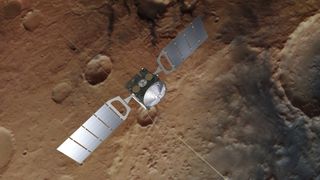Mars probe running Windows 98-era software receives update after two decades
Mars Express probe receives an update in space

Patch management for the latest versions of Windows might the concern of most of us located here on Earth, but meanwhile, the European Space Agency’s (ESA) Mars Express spacecraft has received the first major update to its software in 19 years.
The probe first began orbiting Mars in 2003. Its current mission: to discover of signs of liquid water on Mars, including a suspected 20 x 30km lake of salty water buried under 1.5 km of ice in the red planet’s southern polar region.
The updates to the software, originally developed in Windows 98, were conducted by engineers from the Istituto Nazionale di Astrofisica (INAF), Italy, and were fully funded by the Italian Space Agency (ASI).
What does this mean?
The agency said the upgrade will enable the spacecraft to view Mars and its moon Phobos with better levels of detail.
The Mars Advanced Radar for Subsurface and Ionospheric Sounding (MARSIS) instrument on Mars Express sends low-frequency radio waves down towards the planet using its 40-metre long antenna.
Most of these waves are reflected from the planet’s surface, but significant amounts travel through the crust and are reflected at boundaries between layers of different materials below the surface, including ice, soil, rock, and water.
By examining the reflected signals, scientists can map the structure below the surface of Mars to a depth of a few kilometres and study properties such as the thickness and composition of its polar ice caps and the properties of volcanic and sedimentary rock layers.
Are you a pro? Subscribe to our newsletter
Sign up to the TechRadar Pro newsletter to get all the top news, opinion, features and guidance your business needs to succeed!
“Previously, to study the most important features on Mars, and to study its moon Phobos at all, we relied on a complex technique that stored a lot of high-resolution data and filled up the instrument’s on-board memory very quickly,” said Andrea Cicchetti, the MARSIS deputy principal investigator and operation manager at INAF.
He added: “By discarding data that we don’t need, the new software allows us to switch MARSIS on for five times as long and explore a much larger area with each pass.”
Correction (July 02):
This article has been updated to reflect the fact the Mars Express probe does not itself run on Windows 98, but rather software developed using Windows 98, and to clarify its purpose.
Will McCurdy has been writing about technology for over five years. He has a wide range of specialities including cybersecurity, fintech, cryptocurrencies, blockchain, cloud computing, payments, artificial intelligence, retail technology, and venture capital investment. He has previously written for AltFi, FStech, Retail Systems, and National Technology News and is an experienced podcast and webinar host, as well as an avid long-form feature writer.
